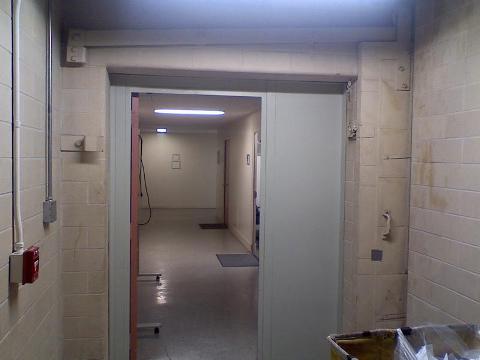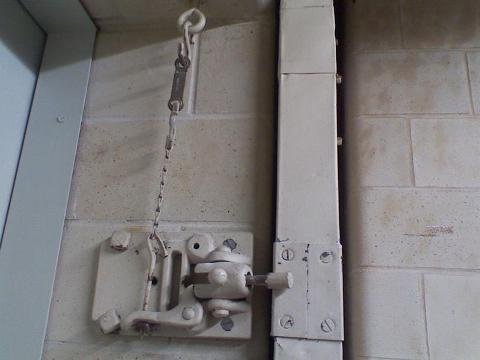Clayton Moorman & Grant Walker, firefighters from NIST Fire Department in Gaithersburg (MD) sent in these photos of a sliding fire door they found on the NIST campus. Sliding fire doors are much more popular than you may think, the problem is you never realize they are present. Many times when the door is open, it is hidden between two walls. The picture below shows the door (in the open position) on the right side of the opening mostly hidden in the wall. The sliding fire door has a pull handle and is painted the same color as the wall (not the grey door.) Also visible is the angled track above the opening, and the receiving “guide” on the right side of the opening.

The purpose of the door is to provide fire and smoke separation in fire rated walls and corridors (hallways.) These doors reside on an angled track that allows gravity to close the door automatically. The doors are held open either by a fusible link (as shown in the picture below), or electromagnetic fire alarm interface. When heat builds up or the fire alarm activates these doors close pretty quickly, we would say that they slam shut but we’re sure someone would correct us on that. These doors are typically quite heavy and take some effort to open back up. Remember they are weighted so gravity closes them…

Obviously the problem is that these doors could close behind us and cut off our primary means of egress. They could also slam shut and kink or possibly even sever the engine company’s umbilical cord (hose line) …Lighten up fellas, just kidding about the umbilical cord thing. We have plans to shoot some video of one of these doors in operation and will post a follow-up in the somewhat near future.
As with everything else in the fire service there is an NFPA standard (NFPA 80) that covers the installation, inspection, and everything else concerning these doors. So they are definitely allowable by code. One specific purpose these doors are used for is to provide fire separation in openings greater than 8 feet wide. Not the case in this particular installation. Eight feet is the magic number that can no longer be protected by standard set of double swinging fire doors. Fortunately some of the larger sliding doors may actually have a smaller egress door present to allow someone to pass through the larger door once it slides into place. It won’t help with the hose line issue, but at least it may allow us to get out easier. However this egress option is not very common.
A quick discussion with the inspectors in your fire prevention bureau may be very helpful in locating these doors in your area. Odds are they know where most of them are. However don’t be fooled if they don’t know of any off hand, they may still be out there. The inspectors may not originally think much about our concerns in operating in building that contain these doors. Take the time to explain to they why it’s important for us to know about them, and you’d be surprised with how quickly they alert you to them in the future.
On a related note, many firefighters know of the import role that the National Institute of Standards & Technology (NIST) has in the fire service. They do an amazing amount of research to make our jobs safer and more efficient. However, most probably didn’t know (we didn’t) that NIST actually has their own fire department that covers the NIST campus. We thought it was worth mentioning.

Delta Oscar November Kilo Echo Yankee Kilo India Charlie Kilo!
That would be a Bravo India Golf Alpha Sierra Sierra Delta!
My full time job is as a jailor, we have three buildings connected by a tunnel. In the tunnel is a similar type door but it drops from the ceiling rather than slides. We have a similar drop down door that is used to turn an unsecure loby into a secure evacuation for inmates.
This brings me to another point. If in a secure facility (like a jail) there may be doors that need to be shut to keep the evacuation secure, there should be a staff member assigned to help (we have turnout gear and SCBA). If I can I will get some pictures to illustrate the doors we have.
and if the donkey kick fails go for the C-4!
I have seen these doors in the past, but have never had them in operation. I’m guessing a standard set of vice-grips or something similar in the track will be enough to prevent it from closing? Or because of the weight is something more substantial needed?
Perhaps beating the track with a sledge so it wedges the wheels will work…just a thought
…hmmm…this is even legal in jersey?
DMAN72, It took me a few times reading your post to figure it out… Well played sir!!
There is a major trauma center just out of my response district that has fire doors that come down from the ceiling. I have offten wondered about them while walking through there. I will try to snap some pictures next time I am up there.
I wonder if a latex glove was wedged in the track,would that stop it from closing??
If the vise-grips were up against the door I would be confident they would hold. If the door could gain momentum before it strikes the vise grips (or any other tool) I would be concerned (and then possibly dead) that the tool would become dislogged.
The sliders I have seen many times do not have track except up high. Maybe pull a large furniture item into the path?
I also saw several of these in a nightclub years ago. The wide open area was several storefronts wide with the walls between buildings removed and these doors installed to partition off the joint if it lit up.
I have also seen these in department stores where you would not notice them unless you looked for them. These were drop-downs versus sliders. The drop ceilind exposed only the slit where the door would drop. In these, there was no way to block them other than pull a large item into the path.
I just googled SLIDING FIRE DOORS and clicked on IMAGES. You’ll find dozens of such photos. Also try OVERHEAD FIRE DOORS and ROLLING FIRE DOORS.
DREW – Thank you for the google idea. Another great tool is to google stuff like this.
We have many of these in older Timber Frame buildings. Most of them still exist only in industrial buildings. In most cases while they may be allowable by NFPA 80, the fusible link is not allowed as a hold open device on self-closing, self-latching doors which must either remain closed or release upon smoke detection. We had many places that tried the fusible link as a hold-open for “normal” rated doors but the fusible link was placed near knob height rendering them nearly useless until far too late. As was noted, our people are shown to wedge or otherwise block these open, when necessary as close to the door as possible to eliminate any momentum.
http://www.youtube.com/watch?v=4E5MRGiBHt8
Dammit! After 8 years I get a new computer at work and now I need another new keyboard! That was the funniest GD thing I have seen in a long time!
I’ve seen these in some dorm/apartment buildings. I’ve seen them welded in the open postition sometimes, too. I’ve also seen doors in an old age home that close the openings around the top of the mezzanine level in the front lobby for smoke control. These are operable by the fd for use of ventilation if needed. They are comparable to roll up garage doors.
well, if you would just have the electricians run some conduit over the doors, that would probbably hold them open long enough to tie off the probie to its fuseable link system to hold it open.
As a safety to the conduit you could also require instalation of a gas line.
Would not tamper with these doors because they do serve a function in the event of a fire. How ever in a life safty issue where it is better that the doors do not close all you need to do is put a small object such as a screwdriver under the leading edge of the door as these doors roll down hill in order to close, The weight of the door will land on the screwdriver as it comes closer to the floor and will stop it or hold it in place as long as the object you put there “fills the Gap”